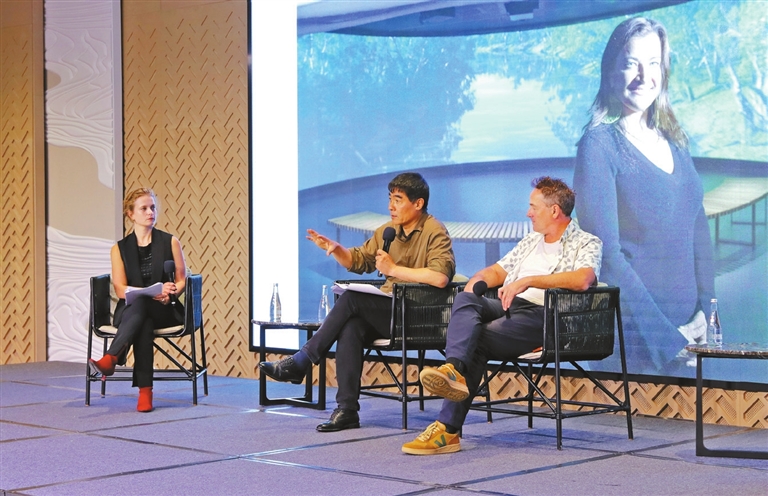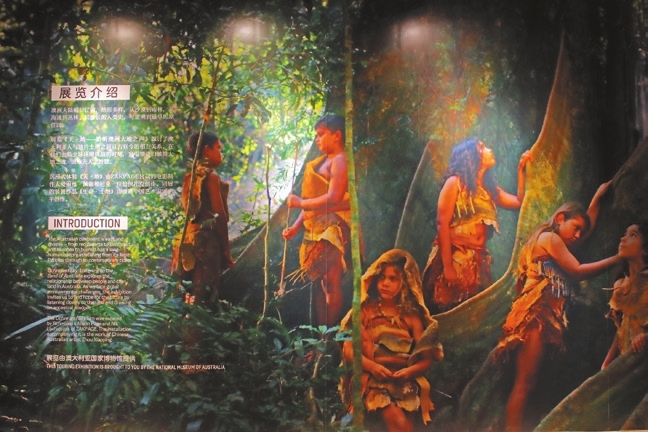



Debra Li debra_lidan@163.com THE Australian continent is vast and diverse — from red deserts to rainforest and beaches to bush. Its long human history dates back to the First Peoples, the aboriginal people that comprise only 5% of its total population today. An exhibition at the Guangming Culture and Art Center through May 12 is bringing the stunning landscapes of Australia to local viewers via a digital film shown on a wide curved screen. Produced by artist couple Alison Page and Nik Lachajczak, the 11-minute film “Ochre and Sky” presents scenes of ancient ceremonies of bathing a baby in a creek amidst forests, and praying and welcoming a new day by the sea, as well as modern life scenarios such as lovers in a boat, workers in a factory, and surfing kids, all set against the backdrop of Australia’s splendid natural landscapes. One scene features First Peoples children hide behind trees listening as their counterparts from modern big cities explore through the same forest, conveying via vivid imagery the message that people of different times and places share the same planet we call home, and we can build a more sustainable future by listening closely to the land and drawing on ancestral wisdom. While Page, a descendant of the Walbanga and Wadi Wadi people from La Perouse, New South Wales, wasn’t present at the opening ceremony Friday afternoon, she created an installation comprising of four totem poles to go with the exhibition. Painted white, red, yellow, and black, the poles feature simple vivid patterns of the aboriginal tribes. The exhibition also features an installation by Chinese-Australian artist Zhou Xiaoping, who employs rice to “paint” on a huge rectangular terraced “canvas” on the floor. “Both First Nations and Chinese people have upheld strong family values, among all the similarities between ancient First Nations and Chinese cultures,” Zhou explained. “Rice is employed as a medium to portray the significance of land, nature, life, and love for family. Rice is a favorite food of both southern Chinese and Australian Aboriginal peoples.” Zhou, born and educated in China, went to Australia in 1988 and has spent many years among its aboriginal people, creating in collaboration with local artists and drawing inspiration from the aboriginal culture. “I was struck by their respect and awe towards nature,” he said, recalling one experience where the local tribe leader prayed and asked for permission from the land before leading him into a forest. “He was very pious, believing that the nature has a mysterious power that all need to revere.” Reminiscing about the tough journeys made into the bushes and red deserts to shoot the stunning scenes and live among the locals, Lachajczak said the job was challenging, given that the work was done during the COVID pandemic, but it was fulfilling as well, because he found deep-rooted ties with the aboriginal communities and their land. “People want to tell their own stories and listen to exciting stories from other people,” Lachajczak said. “Instead of being didactic, I hope to convey the environmental message with subtlety and good storytelling that people can relate to.” Sarah Balzer, an international relations manager from the National Museum of Australia, which curates the touring exhibition, said the film is an immersive experience that urges urbanites to stop and ponder on the relationship between their lifestyles and nature, and perhaps take small steps to contribute to environmental protection. “Watching the film, with all the wonderful visuals and acoustics, is a healing experience,” commented a young white-collar worker at the exhibition. The “Ochre and Sky” exhibition, subsidized by the National Foundation for Australia-China Relations, has previously toured to Tianjin, Beijing, and Zhenjiang in Jiangsu Province. | 
